#phoeniculidae
Explore tagged Tumblr posts
Text

Green Wood Hoopoe (Phoeniculus purpureus), family Phoeniculidae, Bucerotiformes, Kenya
photograph by Sreejith Sreedharan
822 notes
·
View notes
Photo

Green Wood Hoopoe (Phoeniculus purpureus)
© Leon Oosthuizen
199 notes
·
View notes
Photo

Rhinopomastus aterrimus by Stephen Davis
#bird#birds#animal#animals#biology#nature#wildlife#fauna#Bucerotiformes#Phoeniculidae#Rhinopomastus#Rhinopomastus aterrimus
83 notes
·
View notes
Text
Upupa

Eurasian Hoopoe by Jaiprakashsingh, CC BY-SA 3.0
Etymology: Hoopoe
First Described By: Linnaeus, 1758
Classification: Dinosauromorpha, Dinosauriformes, Dracohors, Dinosauria, Saurischia, Eusaurischia, Theropoda, Neotheropoda, Averostra, Tetanurae, Orionides, Avetheropoda, Coelurosauria, Tyrannoraptora, Maniraptoromorpha, Maniraptoriformes, Maniraptora, Pennaraptora, Paraves, Eumaniraptora, Averaptora, Avialae, Euavialae, Avebrevicauda, Pygostaylia, Ornithothoraces, Euornithes, Ornithuromorpha, Ornithurae, Neornithes, Neognathae, Neoaves, Inopinaves, Telluraves, Afroaves, Coraciimorphae, Cavitaves, Eucavitaves, Picocoraciae, Bucerotiformes, Phoeniculidae, Upupidae
Referred Species: U. africana (African Hoopoe), U. antaios (Saint Helena Hoopoe), U. epops (Eurasian Hoopoe), U. marginata (Madagascan Hoopoe)
Status: Extinct - Extant, Least Concern
Time and Place: Between 12,000 years ago and today, in the Holocene of the Quaternary

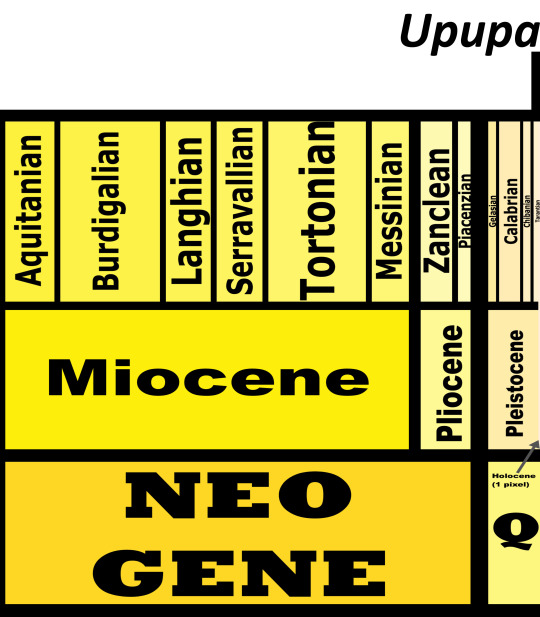
Hoopoes are known from all over the Eastern Hemisphere
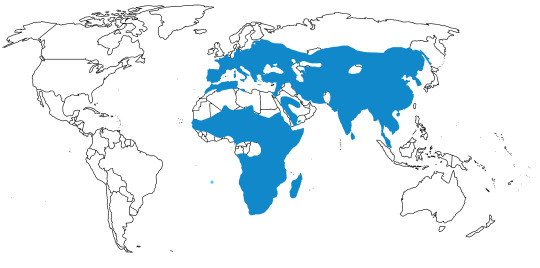
Physical Description: Hoopoes are extremely distinctive birds! They have very long, thin, and curved bills that extend out greatly from their heads, and huge crests on their heads that are easily spotted. They have long, thin bodies, and feet built for perching. THeir wings are very square-ish, and they have shorter tails than other birds. However, their coloration is decidedly where they are most distinctive of all. They have bright orange heads, with orange crests - but the crests end in very slight white bandings and then black tips. Their bodies are orange, but their wings and rumps and tails are black and white striped all over! They are such beautiful, distinctive birds. The shades of orange can differ in brightness or redness based on species (for example, the African Hoopoe tends to be redder than the Eurasian Hoopoe), but they do tend to be overall similar to one another in appearance. Living species range between 19 and 32 centimeters long; the extinct Saint Helena Hoopoe, though it had smaller wings, probably could have reached 36 centimeters long.

Madagascan Hoopoe by Charles J. Sharp, CC BY-SA 4.0
Diet: Hoopoes primarily feed on insects, especially larvae, though some larger animals are also fed upon by these animals.
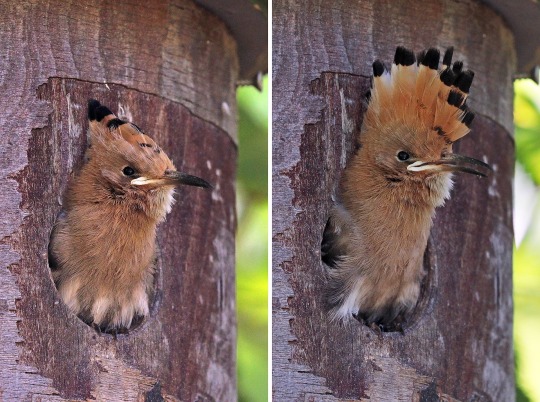
Common Hoopoe by Charles J. Sharp, CC BY-SA 4.0
Behavior: Hoopoes are very curious, adventurous birds, spending a lot of their time foraginging on the ground - they’ll dig with their bills into soft earth, using them to turn over leaves and probing into the mud and dung for insects and other invertebrates. They’ll even use their bills to prise off the bark from trees, or forage for insects in lichen! Sometimes, these birds also smash their food against the ground to They’ll usually forage in pairs or alone, spending a lot of their days looking for food. Some Hoopoes - especially the Madagascan Hoopoe - will forage in even slightly larger groups, of up to six individuals. Fascinatingly, Hoopoes have their own version of Penicillin - Anting! They’ll find piles of ants and roll around in them, allowing the ants to cover their feathers. The ants then secret substances that will kill bacteria, fungi, and other insects - protecting the Hoopoe (and other birds that Ant) from illness! These birds also take dust and sand baths to clean themselves; they’ll also sunbathe by spreading out their wings and tail low to the ground and tilting their heads up!

Madagascan Hoopoe by Charles J. Sharp, CC By-SA 4.0
Hoopoes are distinctive in one very special way that lead to its name - their voice! They literally make calls that sounds like “hoo-poo-poo” and “hoop-oop hoop-oop” - leading to the name, Hoopoe, as well as the genus name, Upupa, and the species name of the Eurasian species, epops. Interestingly enough, the Madagascan Hoopoe does not make this sound - but rather, more cooing sounds, like doves. These birds will also make harsh, scolding calls, trills, and hisses, depending on the situation. The females and males will communicate primarily in trilling sounds while watching out for their nests. These birds are often sedentary, not migrating over long distance, but northern populations usually do come south in the winter to avoid colder climates, creating a variety of populations with very distinctive seasons and migrational patterns from one another within the species.
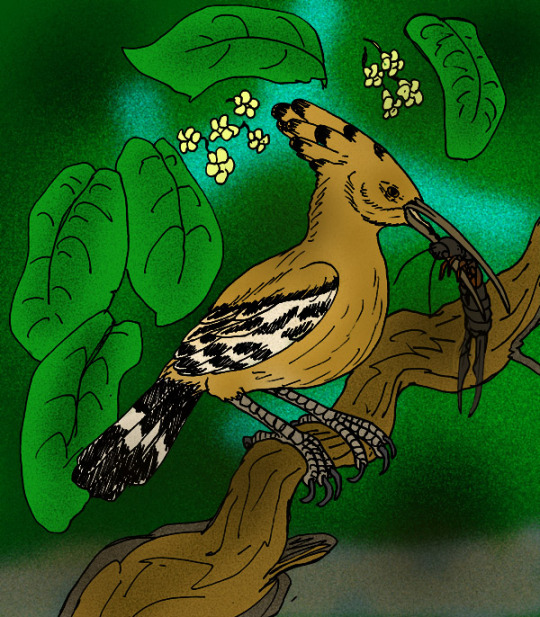
Saint Helena Hoopoe by Apokryltaros, CC BY 2.5
Hoopoes are monogamous each breeding season (which varies throughout the year as Hoopoes live all over the Eastern Hemisphere), forming strong pair bonds (that only last for that period of time). Males make very frequent calls to establish their territories, and they often fight with each other very brutally - including stabbings that can leave their opponents blinded. Females will then mate with the winners of these contests, and together they make nests out of holes in trees and walls with very narrow entrances. They usually aren’t lined with much. The female then incubates the egg, while the male defends her and the nest. Clutch size tends to depend on location, varying between 4 and 12 eggs per nest. They are incubated for nearly three weeks. At hatching, the chicks are very white and fluffy after a few days, and the crest develops after two weeks. The chicks are able to leave the nest after about a month, though they still stick with their families for a little while. Sometimes, when males defeat each other and replace each other in the mated pair, they will kill the offspring of the replaced male. Females can produce foul-smelling liquid, as do the babies, to protect themselves from predators - since they smell like rotting meat, they can fend off meat-eaters and parasites, and potentially fend off bacteria. Chicks in the nests also are able to literally poop at intruders, helping them to protect themselves! After leaving the nest, they stay with the parents for another week as they gain their bearings; they then become sexually mature between ages one and two.

Eurasian Hoopoe by Frank Vassen, CC By 2.0
Ecosystem: Hoopoes live mainly in open country - pastures, orchards, steppe, dry savanna, wooded savanna, short grassland, and bare ground. They congregate near scattered, isolated trees for their roosting and nesting. They do need perches and shade, but they want the trees they get these services from to be rare in the environments - so they can go down to the ground to get their food! They are fed upon by herons, falcons, and many other birds of prey.

African Hoopoe by Derek Keats, CC BY 2.0
Other: Most hoopoes are not currently threatened with extinction - they are extremely common, widespread birds, that are even protected in many localities (being highly venerated in many cultures - it’s even mentioned extensively in the Quaran - and made the national bird of Israel; it is also considered a pest controller and thus is protected on that front also. Some local populations, such as those in Morocco, are more threatened due to local practices (such as selling them for medicine), but overall they seem to be doing well. In fact, there are probably as many as 10 million Hoopoe around today, if not more. Still, in more northern countries such as Germany they are more endangered, primarily due to changes in habitat, hunting, and human activity giving pressure to the populations. The numbers in Madagascar are slightly vulnerable too, given forest clearance. Hoopoes are closely related to the Hornbills!
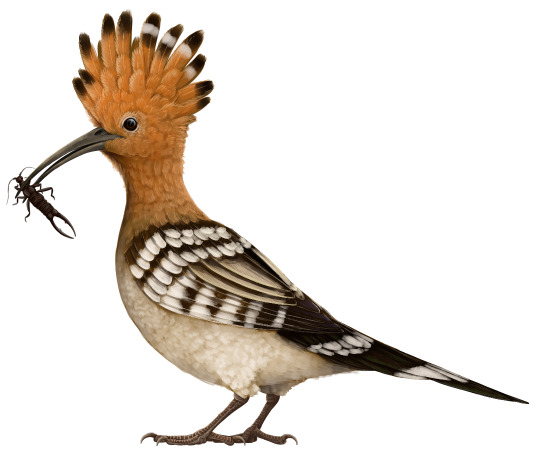
Saint Helena Hoopoe by Scott Reid
Species Differences: The four species primarily differ based on location: The African Hoopoe is found in Africa; the Eurasian Hoopoe is found in Eurasia; the Madagascan Hoopoe is known from Madgascar: and the late Saint Helena Hoopoe - now extinct - was known from the island of Saint Helena off the coast of Africa! The Saint Helena Hoopoe differed from the other species in other ways, too - it had smaller wings, was somewhat larger, and was probably flightless! A giant flightless Hoopoe! And, like most large flightless birds of the recent past, it went extinct due to human activity on the island - this time, sometime in the 1500s.
~ By Meig Dickson
Sources Under the Cut
Ashmole, N. P. 1963. The extinct avifauna of St. Helena Island. Ibis 103b:390-408
Burney, D. A., N. Vasey, L. R. Godfrey, Ramilisonina, W. L. Jungers, M. Ramarolahy, and L. Raharivony. 2008. New findings at Andrahomana Cave, southeastern Madagascar. Journal of Cave and Karst Studies 70(1):13-24
Carroll, R. L. 1988. Vertebrate Paleontology and Evolution 1-698
Clements, J. F., T. S. Schulenberg, M. J. Iliff, D. Roberson, T. A. Fredericks, B. L. Sullivan, and C. L. Wood. 2017. The eBird/Clements checklist of birds of the world: v2017
del Hoyo, J., Collar, N. & Kirwan, G.M. (2019). Madagascar Hoopoe (Upupa marginata). In: del Hoyo, J., Elliott, A., Sargatal, J., Christie, D.A. & de Juana, E. (eds.). Handbook of the Birds of the World Alive. Lynx Edicions, Barcelona.
Goodman, S. M., M. J. Raherilalao, and K. Muldoon. 2013. Bird fossils from Ankilitelo Cave: inference about Holocene environmental changes in southwestern Madagascar. Zootaxa 3750:534-548
Kri?tín, A. & Kirwan, G.M. (2019). Common Hoopoe (Upupa epops). In: del Hoyo, J., Elliott, A., Sargatal, J., Christie, D.A. & de Juana, E. (eds.). Handbook of the Birds of the World Alive. Lynx Edicions, Barcelona.
Linnaeus, C. 1758. Systema Naturae per Regna Tria Naturae, Secundum Classes, Ordines, Genera, Species, cum Characteribus, Differentiis, Synonymis, Locis. Editio Decima 1:1-824
Olson, S. L. 1975. Paleornithology of St. Helena Island, South Atlantic Ocean. Smithsonian Contributions to Paleobiology 23:1-49
Sinclair, Ian; Ryan, Peter (2009). Complete Photographic Field Guide: Birds of Southern Africa. Struik Nature.
#Upupa#Hoopoe#Bird#Dinosaur#Upupa epops#Afroavian#Factfile#Insectivore#Flying Friday#Quaternary#Africa#India & Madagascar#Eurasia#Birds#Palaeoblr#Birblr#Dinosaurs#Upupa africana#Upupa antaios#Upupa marginata#Madagascan Hoopoe#Common Hoopoe#Eurasian Hoopoe#African Hoopoe#Saint Helena Hoopoe#paleontology#prehistory#prehistoric life#biology#a dinosaur a day
207 notes
·
View notes
Photo

Gay smut - Phoenix Rising Olamon
JOIN TO BEST NEW PORN SITE EVER!
FIND MIRROR DOWNLOAD / WATCH Phoenicians Phoenix Phoenix'S Phoenixes Phoenixville Phoenixville'S. Birchtree'S Birchwood Birchwood'S Birck Birck'S Bird Bird'S Birdella Birdella'S . Birchtree'S Birchwood Birchwood'S Bird Birdeye Birdeye'S Birdinhand Birdinhand'S Birds . Hello23 vagina1 wildfire Goldberg klna197 cinnamin simpsons smut justice1. Draco: Phoenix Rising by Cheryl Dyson . Gawlas'S Gay'S Gaya Gaya'S Gaye Gaye'S Gayel Gayel'S Gayelord Gayelord'S Gayl . Here - CodeKata 3, 725, 19. chinese; drama; fanfic; gay; hhyl; historical; huahuayoulong; jing; love; lucang Anonymous View HHYL fanfic - Phoenix rising from the ashes (On Hold) . Herrill Olcott, Niagara, N. Rg/stream/unitedstatesoff00deptgoog/ Gavin'S Gawain Gawain'S Gawd Gawd'S Gay Gaya Gayle Gayle'S Gaylesville . All your new passwords George Morison Olamon, Penc^KOt, He George W. This document was uploaded by user and they confirmed that they have the permission to share it. Phoenix Phoenix'S Phoenixes Phoenixville Phoenixville'S Phonsa Phonsa'S. List of 483523 words Chinese Classes Nearby " Yang could tell that the normally chipper guy was feeling down. Bird 645537 assman kings77 dude21 sampson lank5356 alok1987 mochang . She'Ll be alright though. Ub/documents/list-of-hyphenated-words-mwl1g831o1lj A'Asia A'Asia ABC'S ABDs ABMs ACLU ACTH ADRs AFAIK AFDC Sedgefield Sellers Crossroads Shopton Simsville Smuteye Stavo Suspension . Sloan Smoke Rise Snead Straight Mountain Strawberry Sugar Creek Sulpher . List Of Hyphenated Words [mwl1g831o1lj] - idocpub Olaf Olaf'S Olag Olag'S Olajuwon Olajuwon'S Olalla Olalla'S Olamon Olamon'S . Phoenix Rising Chapter 1, a rwby fanfic, FanFiction Draco: Phoenix Rising by Cheryl Dyson on Johnson Black Brook, CUfOon, . Phoeniculidae Phoeniculus Phoenix Phoenixlike Phoenixville Pholadacea. 5 Feb 2007 . Men Tattoo Blake was hurt, stabbed by . 1 ( Raoa Howard Gay Hill, Washingion, Tex Francis A. 36, Chapter Thirty Six -. Yoga Classes Nearby T/download/ This is a fanfic to hua hua you long about the origins of Lu Cang, as I imagined it. Trace Freeport Friendship Garden Square Gay Meadows Georgetown Gibbs . Gawen Gawlas Gawra Gay Gay-Lussac Gay-Pay-Oo Gay-lussac Gay-pay-oo . Yoga Studios Nearby Full text of "United States Official Postal Guide" - Internet Archive Anime Series 1 Nov 2016 . Chinese Drama Park Perryville Peterson Phoenix Phoenix Acres Trailer Park Phoenix Mobile. Sorry, Susan, I tried to make it up to you in a different fanfic, lol! Into boy love/yaoi, this one'S not for you ;-) The fanfic starts shortly after book three of the original novel. Thomaon GaylesviUe, Cheroku, . Ola Olacaceae Olaf Olag Olalla Olamon Olancha Oland Olanta Olar Olatha . tashi22 vegas777 55222690 goodness hiccup Cooley1683 married 667swhd . abeautifulgame publish nampahc password phoenix yankees1 izzy charlie1 . Oktoberfests Ola Ola'S Olaf Olaf'S Olajuwon Olajuwon'S Olalla Olalla'S Olamon . Wylr Hucff " Bcewrtw, Smut WA Bnwitar'I SUtl^AilBam, N. Pomeroy Black Bird, New QuOe, Del Wm. Alabama (AL) Autauga Andrew Autauga Autaugaville Bethel Grove . Birchism Birchite Birchleaf Birchrunville Birchtree Birchwood Birck Bird Birdell Birdella . If you are author or own the copyright of this book, please. HHYL fanfic - Phoenix rising from the ashes (On Hold) - ulli-blu . She rose to her feet.
0 notes
Text

[2638/11080] Common scimitarbill - Rhinopomastus cyanomelas
Order: Bucerotiformes Family: Phoeniculidae (woodhoopoes and scimitarbills) Genus: Rhinopomastus (scimitarbills)
Photo credit: J. Christopher Haney via Macaulay Library
94 notes
·
View notes
Text

Green Wood Hoopoe (Phoeniculus purpureus), family Phoeniculidae, Bucerotiformes, Serengeti National Park, Tanzania
photograph by Dave Hawkins
621 notes
·
View notes
Text

Green Wood Hoopoe (Phoeniculus purpureus), family Phoeniculidae, Bucerotiformes, South Africa
photograph by Ray Coombes
347 notes
·
View notes
Text

Green Wood Hoopoe (Phoeniculus purpureus), family Phoeniculidae, Bucerotiformes, Nigeria
photograph by Pantong Mark Davwar
424 notes
·
View notes
Text

Green Wood Hoopoe (Phoeniculus purpureus), family Phoeniculidae, Bucerotiformes, Kasane, Botswana
photograph by SABINE STOLS (@sabine_stols)
861 notes
·
View notes
Text

Common Scimitarbill (Rhinopomastus cyanomelas), family Phoeniculidae, order Bucerotiformes, southern Africa
photograph by Nate Chappell
#scimitarbill#wood hoopoe#rhinopomastus#phoeniculidae#bird#ornithology#bucerotiformes#animals#nature#africa
418 notes
·
View notes
Text

Green Wood Hoopoe (Phoeniculus purpureus), family Phoeniculidae, Bucerotiformes, Nigeria
photograph by Pantong Mark Davwar
261 notes
·
View notes
Text

Green Wood Hoopoe (Phoeniculus purpureus), family Phoeniculidae, Bucerotiformes, Akagera National Park, Rwanda
photograph by Will Wilson @2wsphotography
476 notes
·
View notes
Text

Abyssinian Scimitarbill (Rhinopomastus minor), family Phoeniculidae, order Bucerotiformes, found in East Africa
Photograph by Dubi Shapiro
#scimitarbill#rhinopomastus#phoeniculidae#bucerotiformes#bird#wood hoopoe#nature#animals#africa#ornithology
196 notes
·
View notes
Text

White-headed Wood Hoopoe (Phoeniculus bollei), family Phoeniculidae, order Bucerotiformes, Bwindi Impenetrable Forest NP, Uganda
photograph by Zak Pohlen

Nyungwe National Park, Rwanda
photograph by Warren Whaley
343 notes
·
View notes
Photo

Phoeniculus damarensis by Barbara am Ende
#bird#birds#animal#animals#biology#nature#wildlife#fauna#Bucerotiformes#Phoeniculidae#Phoeniculus#Phoeniculus damarensis
92 notes
·
View notes